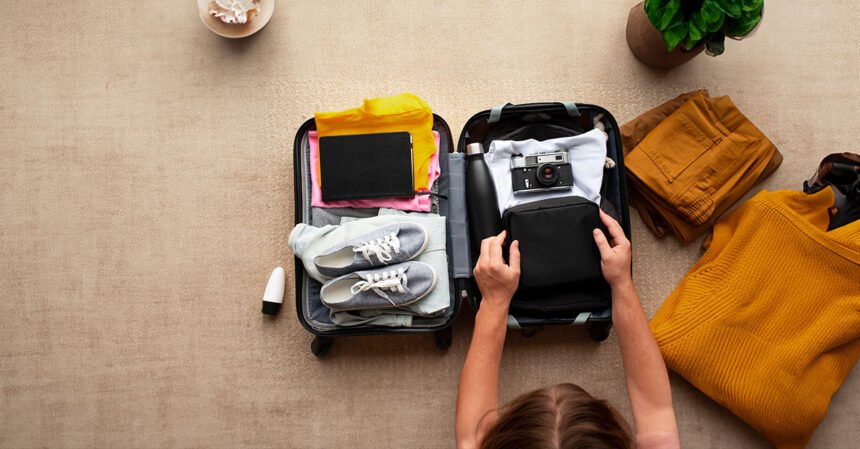Due to ever-evolving security regulations, it may be challenging to determine what items should be packed for a flight. Proper packing techniques will make every trip less complicated and stressful – whether this is your first experience flying or one of many. This article will give you important packing tips and tricks that will help you bring things on a plane with ease and confidence.
Research Airline And TSA Guidelines:
Be sure to take time before traveling to get acquainted with both the Transportation Security Administration (TSA) and your airline policies and procedures. Carry-on luggage restrictions may differ depending on which airline is involved; weight, size, and content restrictions could all vary based on these regulations; in addition, TSA sets guidelines regarding what can and cannot be packed into carry-on bags – it would be wise to familiarize yourself with them prior to making plans to visit an airport – so as to comply with all necessary security regulations without unnecessary delays.
Choose The Right Carry-On Bag:
Selecting an effective carry-on luggage is crucial to successful packing. Select one that is TSA-approved, sturdy, and meets airline regulations; during security inspections, make sure it has enough pockets and sections to keep all your belongings organized and easily accessible; when considering space in an airline cabin, consider both form and size as well as any size restrictions or size limits of the suitcase you choose.
Pack Strategically:
Organization is key when packing a carry-on bag. Begin by creating a list of ID, medications, electronics and personal care products you will require most on the flight; place these in separate pouches or compartments so they’re easily accessible; using compression bags or packing cubes will maximize space usage while still keeping clothing wrinkle-free – remember clothing can also be rolled to save space by rolling rather than folding.
Follow The 3-1-1 Rule For Liquids:
One major source of ire at airport security inspections is improper handling of liquids. 3.4 ounces (100 milliliters) or less of clear, quart-sized plastic bags are required for all liquids, gels, and sprays under TSA rule 3-1-1. Individuals are permitted to bring one of these bags, but it must be removed from the carry-on and placed in a container for screening. Your carry-on bag can expedite the procedure if you arrange your liquids in a separate pouch that is conveniently located for scrutiny.
Minimize Electronics And Accessories:
As long as they are taken out of their cases and subjected to a separate security screening at the airport, electronics such as computers, iPads, and iPhones can typically be brought on board in carry-on bags. Pack your electronics in a laptop sleeve or bag that the TSA will accept, which will make it easier to remove them in order to expedite the procedure. To reduce clutter and make things easier for security screening, pack as few accessories and cords as possible.
Be Mindful Of Prohibited Items:
A list of things that are prohibited by the TSA and are not permitted to be carried on in carry-on bags is kept up to date for everyone’s protection. Among these are weapons, explosives, sharp objects, and certain sports gear. Make sure you check your suitcase carefully before packing and take out anything that can break TSA rules. Be mindful of certain limitations on things like lithium batteries as well, as these can require either extra care or permission from airline personnel.
Plan For Security Checks:
Preparing to go through airport security can take longer, but being prepared will make the experience smoother. When there are many passengers, arrive early so there is sufficient time for security procedures and screening procedures. You will have to remove your shoes for screening procedures – choose sneakers with quick lace-up/unlace-up capabilities for easier stepping through security lines. Make sure you bring along your boarding pass and travel documentation and be ready to comply with TSA officers’ directions to speed through security more swiftly.
Consider Checked Luggage For Bulkier Items:
You can only bring certain items onboard with you, even if carry-on luggage is more convenient and accessible, instead of checking your luggage if you’re carrying large or bulky things that don’t fit in the carry-on category. Big bottles of fluids, baggy clothes, and sporting goods are examples of this type of merchandise. Discuss the particular guidelines regarding the quantity and cost of checked baggage when speaking with your flight attendant.
Conclusion:
In summary, it’s not always a difficult undertaking to pack for a flight. These expert packing suggestions can help you pack for travel in style and safety, making your trip hassle-free from beginning to end. Consider checking bags for larger things, keep in mind to follow the 3-1-1 rule for liquids, minimize electronics and accessories, research airline and TSA standards, select the appropriate carry-on bag, pack thoughtfully, and be aware of forbidden items. You’ll be ready to soar over the skies with assurance and serenity if you’ve appropriately organized and prepared.


Leave a Reply